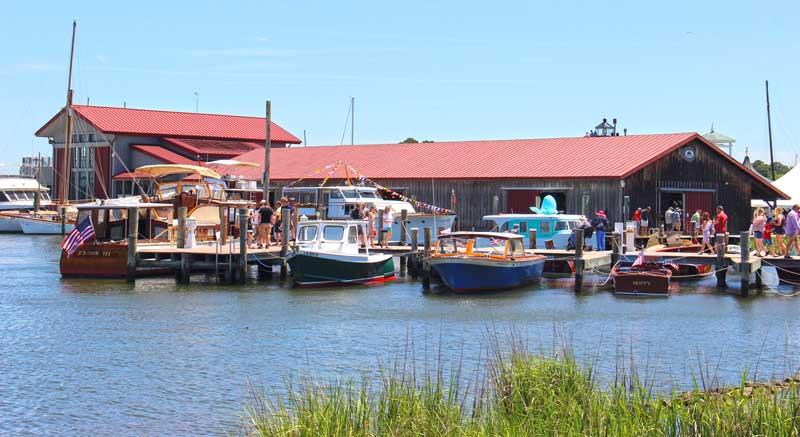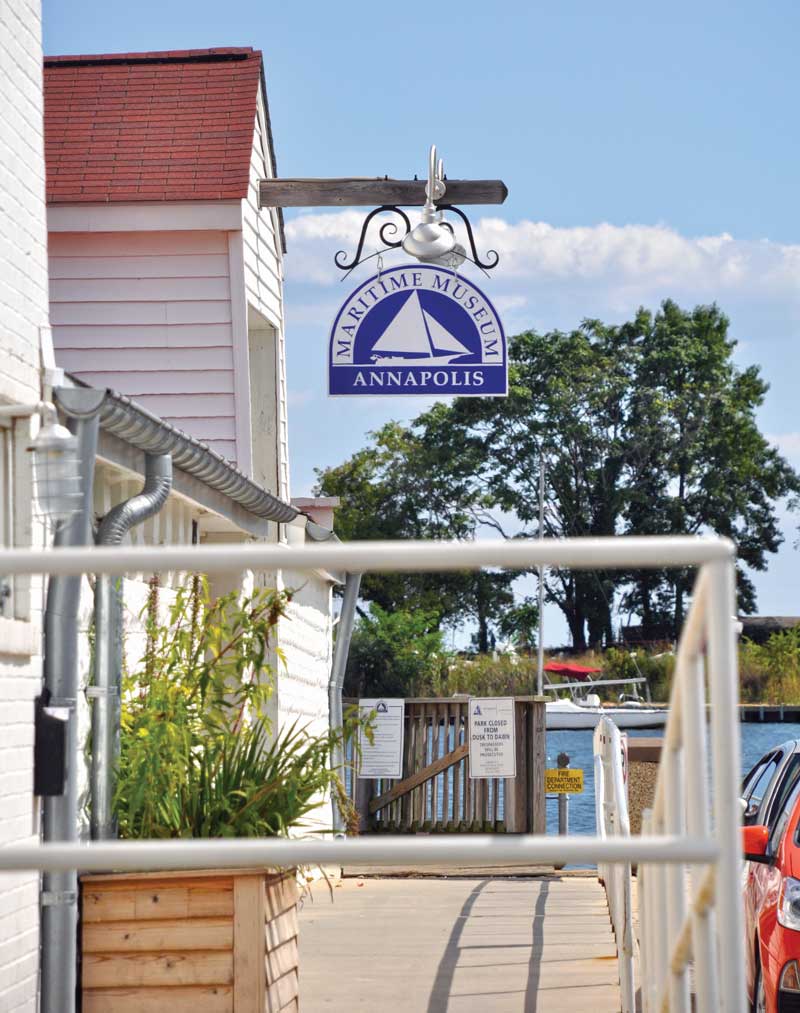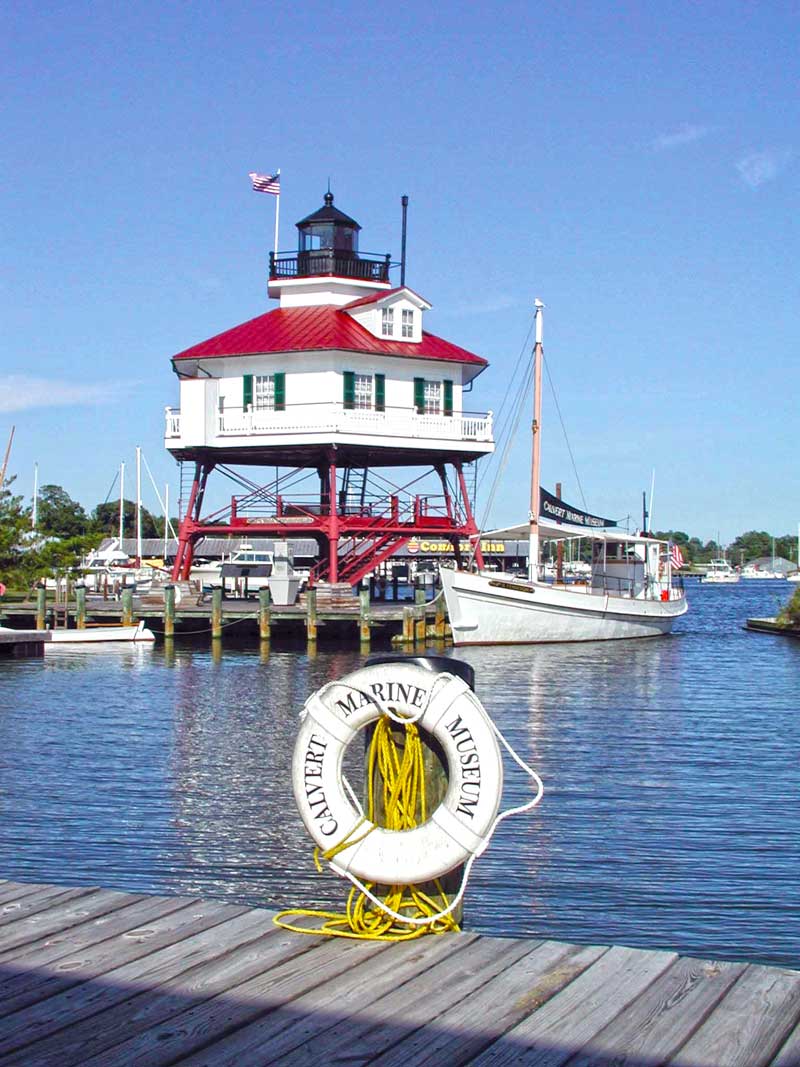If you're looking to expand your Chesapeake knowledge this winter, maritime museums offer a great opportunity to celebrate the rich history of the Chesapeake Bay. Many are even offering virtual learning opportunities if you prefer to stay closer to home. These are not the only maritime museums around but they are some of the big ones.

The Annapolis Maritime Museum and Park
The Annapolis Maritime Museum and Park (AMMP) is housed in the historic McNasby Oyster Company, the perfect setting to educate the public on the region’s proud maritime history, the ecological diversity of the Bay, and the environmental impacts of humans due to over-harvesting and depletion of the oyster population. The waterfront campus includes three transient piers and an adjacent beachside park—the only one in Annapolis—where visitors can launch personal paddlecraft such as kayaks and standup paddleboards.
Located across Back Creek from AMMP’s McNasby Campus is the museum’s Ellen O. Moyer Nature Park Campus. This renovated, 12-acre park accommodates AMMP’s ever-expanding education programs, helping to further develop the curriculum to include natural sciences through hands-on activities. In 2019, AMMP entered a new partnership with Capital SUP in an effort to further encourage public access to the Bay. The standup paddleboarding company is now located within the park campus.

The Annapolis Maritime Museum is also one of four partners in a consortium that took over ownership of the iconic Thomas Point Shoal Lighthouse. The museum joined the Chesapeake Chapter of the U.S. Lighthouse Society, the City of Annapolis, and Anne Arundel County to manage and preserve this beloved National Historic Landmark. Built in 1875, the Thomas Point Shoal Lighthouse is the last screwpile lighthouse on the Bay still in its original location. From June through October, guests can take a boat ride to the lighthouse for a docent-led tour.
Other tour options include cruises aboard the skipjack Wilma Lee, built in 1940 and one of only a few remaining Chesapeake Bay skipjacks. Public cruises occur April through October and are currently capped at 23 passengers including captain and crew due to Covid-19.
AMMP even has virtual learning resources available on its website so that you can continue to learn about the Bay from the comfort of your own home. Current virtual exhibits include: “Dynamically Different: the Owens Yacht Company;” “Arnie Gay: The Father of Annapolis’s Modern Sailing Industry;” and “Crab Pots, Eel Spears, and Fish Nets: Seasonal Changes in Watermen’s Work.”
Calvert Marine Museum
The Calvert Marine Museum (CMM) in Solomons, MD, invites guests to explore the unique story of the Chesapeake Bay, from our prehistoric past to our maritime heritage and natural environment. A particular draw of CMM is the Paleontology Gallery with a life-size diorama that recreates the world of the Miocene and a 35-foot skeletal restoration of the extinct Miocene giant white shark, Carcharocles megalodon. At the end of the gallery visitors will find the fossil preparation lab where trained volunteers prepare fossils found along the beaches of Calvert Cliffs. At the touch tank, interpreters are always on hand to introduce guests to some of the curious creatures in the Chesapeake Bay and nearby Atlantic Ocean including horseshoe crabs, diamondback terrapins, sea stars, and prickly sea urchins.
Also of interest are the Maritime History Gallery, the scenic Marsh Walk, the screwpile Drum Point Lighthouse (decommissioned in 1962 and moved to CMM in 1975), the historic buyboat Wm. B. Tennison which offers sightseeing cruises around Solomons Island, the skipjack Dee of St. Mary’s, and a host of changing exhibits. Off-site, the museum maintains the J.C. Lore & Sons Oyster House, a national historic landmark located less than a mile away, and the Cove Point Lighthouse which is open to the public as a weekly vacation rental. Throughout the year, CMM hosts many events, including children’s activities, lectures, and the very popular Waterside Concert Series.

This fall, to commemorate the museum’s 50th anniversary, CMM invites the community to participate in its 50 Miles for 50 Years Virtual Challenge. The challenge runs October 18 to November 18, and participants must complete 50 miles of activity during the month. You’re encouraged to log all “intentional miles,” so run, walk, bike, hike, swim, or hit up the gym, the trails, or your own staircase to achieve 50 miles, which is about 1.5 miles per day. This challenge is virtual so that you can participate with your friends and families at your own pace and at your own place. During the challenge, CMM staff will share local route ideas and fun weekly challenge cards. Enter and/or make a donation at runsignup.com/cmm50for50.
Chesapeake Bay Maritime Museum
Established in 1965, the Chesapeake Bay Maritime Museum (CBMM) is an educational organization dedicated to preserving and exploring the history, environment, and culture of the entire Chesapeake Bay region, and making this resource available to all. Located in St. Michaels, MD, CBMM’s campus includes a floating fleet of historic boats, 12 exhibition buildings, and changing special exhibitions, all set on the waterfront of the Miles River and St. Michaels’ Harbor. The museum serves more than 75,000 guests each year, and its collection of historic Chesapeake Bay watercraft—maintained by shipwrights and their apprentices in the museum’s working shipyard—is the largest in existence. Catch up on current projects at the Shipyard in our Boatshop Reports and at cbmmshipyard.com.
There is always something new to explore at CBMM, such as the living shoreline along the waterfront, the historic Tolchester Beach Bandstand (circa 1880) and the Point Lookout fog bell tower (circa 1888); and many other permanent exhibits that call CBMM home. Guests can step aboard the oyster harvesting skipjack E. C. Collier and enter the world of the working watermen of the Chesapeake Bay or try their hand at harvesting seafood at Watermen’s Wharf, a recreated crabber’s shanty. There is a history of waterfowling exhibit, along with a Maryland crab meat company exhibit, and of course the Hooper Strait Lighthouse, built in 1879 and moved to CBMM in 1966.
Currently on display is also a new exhibition featuring works by photographer Jay Fleming. “Island Life: Changing Culture, Changing Shorelines” reveals how the changing environment is affecting the cultures and shorelines of inhabited and formerly inhabited offshore islands in the Chesapeake. Explore some of the featured images at cbmmislandlife.org.
Besides its permanent and rotating exhibits, there always seems to be a fun event unfolding on the museum’s campus, including the Mid-Atlantic Small Craft Festival, OysterFest, Watermen’s Appreciation Day, Big Band Night, the Charity Boat Auction, and one of our personal favorites, the Antique and Classic Boat Festival. Here’s hoping these events can return in 2021.
Havre de Grace Maritime Museum
The Havre de Grace Maritime Museum in Havre de Grace, MD, is situated where the Susquehanna River meets the upper Chesapeake Bay, and tells the story of the region’s rich maritime history. The museum was established in 1988, and in 2015, a brand-new Environmental Center and Classroom was unveiled to better educate the community about environmental estuarine, wetland, and upland watershed science and environmental stewardship.
Behind, and immediately adjacent to the museum, is a small tidal wetland, crossed by the Havre de Grace Promenade. The Museum is undertaking the restoration of the wetland and shoreline to create a “living classroom” for its educational programs, and for the enjoyment of the many visitors who come to walk the Promenade.
On the ground floor of the museum, the Boat Shop renovates and restores old wooden boats and builds replicas of early and mid-20th century classic wooden boats. Volunteer boat builders are always welcome to join the team; experience is not necessary. Throughout the year, the museum also hosts a series of lectures, environmental film screenings, a summer concert series, boating classes taught by the U.S. Coast Guard Auxiliary, and Environmental Center programs for children and young adults.
Mariners’ Museum and Park
The 550-acre Mariners’ Museum and Park in Newport News, VA, is an urban oasis, home to the 167-acre Lake Maury and the Noland Trail (a five mile shoreline trail with 14 bridges) and over 90,000 square feet of exhibition galleries, including the prestigious International Small Craft Center, and the award-winning USS Monitor Center. Founded in 1930, June 2 marked the Museum’s 90th year of existence.
The Small Craft Center features nearly 150 boats from 42 countries and is one of the few truly internationally focused collections in the world. The Monitor Center exhibition and conservation lab houses 210 tons of artifacts from the Civil War ironclad Monitor, which were recovered from NOAA’s Monitor National Marine Sanctuary. The Mariners’ Museum Library and Archives is home to over 78,000 books; 800,000 photographs, films, and negatives; and over one million pieces of archival material, making it the largest maritime library in the Western Hemisphere.
The goal of the Mariners’ Museum has always been to connect people to the world’s water. Apart from its many exhibitions, the museum hosts a variety of events and learning activities aimed at fostering its mission, and admission is only $1 per person! As of print time, the museum was temporarily closed, but the Park and Noland Trail remained open. With the museum closed, its popular Evening Lecture Series has moved to a virtual format this fall. The Museum’s lecture series on Civil War and Hampton Roads history is also virtual this year. All virtual lectures are free and require advance registration. Viewers may submit questions and comments to the presenters during their respective lectures. For more information, visit MarinersMuseum.org/Virtual.
For the most up-to-date information regarding each museum campus, visit their respective websites before visiting.